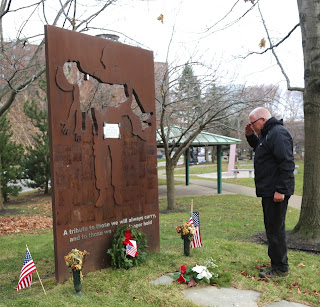From a young age, Jasmine Westbrook understood the importance of blood donation.
“The first time I was introduced to donating blood I was in
high school. We had a drive, but you know, when you’re in high school, you
don’t have the best diet – especially breakfast. You’re not eating right, so a
majority of us, myself included, couldn’t donate,” she laughed. “I initially
donated blood about 10 years ago in college during a drive and I was a little
bit more educated on having a balanced meal the night before and before the
donation.”
“We just want to do good,” Westbook explains. “In the last
five years, I’ve started donating regularly once I really understood what my
blood donation could do. How it could really impact somebody. I was doing it
because I knew it would help people.”
But it was after Westbrook attended a panel discussion on
Sickle Cell Disease co-hosted by Sickle Cell Warriors of Buffalo, the American
Red Cross of Western New York and community partners that she began to look at her role as
a blood donor in a new light.
“I attended and I really learned about the CEK-negative component.”
There are an estimated 100,000 people suffering from the
effects of Sickle Cell disease in the United States. From pain to organ failure,
patients with Sickle Cell often face serious medical complications due to an
inherited gene that creates sickle-shaped red blood cells, causing difficulty
in navigating through small blood vessels. As a result, blood transfusions are
vital to treatment, with some patients requiring approximately 100 transfusions
per year.
Transfusions rely heavily on donors who carry CEK-negative
antigens, which provides the best blood match and helps alleviate symptoms for
those fighting Sickle Cell. Blood donors who are African American are nearly three times more likely
to be CEK-negative than donors of a different race or ethnicity.
To help increase the availability of close-matching blood for
Sickle Cell patients, the American Red Cross launched the Sickle Cell Initiative in 2021. Since the launch, more than 125,000 first-time African
American donors have rolled up a sleeve to help strengthen and diversify the
blood supply. And as part of that initiative, more than 260,000 Sickle Cell trait
screenings have been provided to donors.
“I left that event and wanted to know if I had that protein,
because people talk about blood types, but they don’t always talk about that,”
Westbrook says. “That day, I donated double reds, they tested it, and I got the
card was told I was CEK-negative.”
Since then, Westbrook’s personal and professional motivations
to encourage others to roll up a sleeve have taken on new meaning. A health
care advocate with the Healthcare Education Project, Westbrook works directly
with patients and the public through community events and uses the opportunity
to inspire and educate others to donate not only for themselves but patients – especially Sickle
Cell Warriors in need.
“I feel like it’s my duty because I have a protein in my
blood that allows me to really help people and specifically in the African
American community. A lot of the work that I do is coming back to my cultural
group and knowing that I have the protein in my blood – that will really help
people with sickle cell, which is an illness that is high in our community. Of
course, I’ll share my blood. A big part of my role is advocacy on a statewide
level for access to health care. I’m able to share information with people to
help keep our community more educated, like with Sickle Cell. When the
conversation comes up now, I’m equipped with information to say, ‘Why don’t
you donate and see if you have that protein?’ I’m helping to pass the word
around so we can have a healthier community. So, it’s personal for me and its
business.”
You can learn more and help give to patients in need by
making an appointment to donate at RedCrossBlood.org, by calling 1-800 RED
CROSS (1-800-733-2767) or by downloading the free Red Cross Blood Donor app to
your smartphone.
Meg Rossman, Regional Communications Manager, American Red Cross of Western New York





